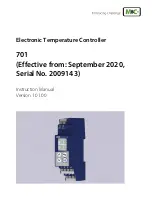
ZEC410 VAV Controllers Installation Instructions
17
Occupancy Sensor
All zone controllers support an occupancy sensor. The occupancy sensor enables the controller to switch to
standby mode from occupied mode when local activity is absent during a set time period in a normally occupied
zone. When in standby mode, the zone controller uses standby temperature setpoints that are higher and lower
than the occupied cooling and occupied heating temperature setpoints, respectively. These standby setpoints help
save energy by reducing the demand for heating and cooling in an unoccupied zone. For VAV zone dampers, the
sensor uses unoccupied flow setpoints in addition to standby temperature setpoints. You can enable the occupancy
sensor in the Zone Setup screen of the System Manager or Zone Coordinator.
You can set occupancy sensitivity
and time delay until standby locally at the sensor. Refer to the
Verasys System User’s Guide (LIT-12012371)
for
more information.
CO
2
Demand Controlled Ventilation (DCV)
CO
2
DCV ensures high Indoor Air Quality (IAQ) for the zone by using up to four wall-mounted CO
2
sensors to
monitor CO
2
levels. The sensor measures CO
2
levels on a scale of 0 to 2,000 parts per million (ppm). When the
CO
2
sensor with the highest CO
2
reading detects that CO
2
levels in the zone are above the setpoint (such as
caused by a high number of occupants within the zone), the zone damper opens, to allow more outside air into the
zone. Enable CO
2
DCV in the Zone Setup screen of the System Manager or Zone Coordinator. Refer to the
Verasys System User’s Guide (LIT-12012371)
for more information.
Troubleshooting
Use the following information to troubleshoot the ZEC controllers.
Power Status LED
A green LED shows the power supply status to the VAV zone damper controller. See Table 4 for a description of the
modes.
Table 4: Status LED for Power (PWR)
Mode
Description
Off
No Power
On
Power is supplied by Primary Voltage (Normal operation)



































